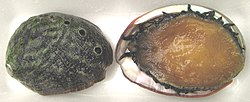Haliotis sorenseni
[4] White abalone are found in open low and high relief rock or boulder habitat that is interspersed with sand channels.
Sand channels may be important for the movement and concentration of drift macroalgae, and a variety of red algae, upon which white abalone are known to feed.
[4] The white abalone is known to be a herbivore, grazing mainly on macroalgae, such as Laminaria farlowii and Agarum fimbriatum, and also several species of red algae.
[4] Other species it eats include Chondracanthus exasperatus, Laminaria farlowii, Macrocystis pyrifera , and Palmaria mollis.
[4] As a broadcast spawning gastropod, white abalone reproduce by releasing their eggs and sperm into the surrounding water.
Such densities were comparable to abundance of shallower species of abalone found in previously unfished or protected areas.
The White Abalone Restoration Consortium is a partnership with the Bodega Marine Laboratory [University of California, Davis], The Cultured Abalone Farm, the Santa Barbara Museum of Natural History Sea Center and the National Oceanic and Atmospheric Administration Southwest Fisheries Science Center on the Gaviota Coast which is studying the marine snail and restoring the wild populations.



open squares - commercial catch per unit effort
left y axis - thousands of pounds of shell per vessel
filled circles - price of Haliotis sorenseni
right y axis - US$ per pound.